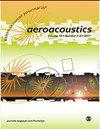设计、组装和测试升级后的航空声学风洞设施
IF 1.2
4区 工程技术
Q3 ACOUSTICS
引用次数: 0
摘要
宾夕法尼亚州立大学航空航天工程系的航空声学实验室目前为多个实验研究领域提供服务。实验室中最著名的是消声室,而航空声学风洞是消声室的组成部分。近年来,主要的研究领域包括飞机排气喷气模型和直升机旋翼模型,其中涉及详细的噪声实验。在喷气噪声领域,应用包括飞机的飞越和起飞配置。在飞越应用中,排气喷嘴周围的气流对辐射噪声有很大影响,必须对其进行模拟,以得出对噪声抑制应用的初步设计最有用的实验结果。宾夕法尼亚州立大学的航空声学风洞可用于模拟。在飞机起飞时,飞机的空速超过每秒 250 英尺,即马赫数超过 M = 0.22。在 2022 年之前的几年中,宾夕法尼亚州立大学设施的自由射流速度被限制在每秒 200 英尺以下。本文报告了一个项目的情况,该项目旨在对现有风洞进行升级设计,以提高试验段的流速,使其更接近 250 英尺/秒的目标值。该方法从回流管道的初步设计开始,将开放式喷射、开放式回流风洞转换为封闭式回流风洞。其概念是利用风洞排气中的流动能量来提高进气风扇的输入能量,从而推动气流进入试验段。初步设计的一个组成部分是利用升级后的流动分析计算机代码来预测新设施试验段速度的增加。根据设备中两个风扇的可用马力,将现有风洞和升级后风洞的配置输入到基于准一维公式的分析代码中。该代码包括经验数据,以包括风洞组件的各种形状。各部分的相对流速采用简单的不可压缩连续性来计算各部分的所有流速。每个断面的平均动压由流动(恒定)密度和速度平方计算得出。每个断面都有一个根据经验数据(来自相关文献)计算得出的非尺寸压力损失参数。基本代码(使用 Excel 算法)基于预测器-校正器概念,计算初始化为测试断面入口处的估计流速和压力。估算随后各段的损失,以确定总压力损失和与回路中两个风机的增益相比的累积损失。根据回路末端的总压力值调整初始猜测值。在相关实验中,对各段之间的几个连接处的总压和动压进行了测量,并与分析代码中的预测值进行了比较。使用了各种驱动风扇的马力设置,并将结果与隧道配置的流量测量值进行了比较(主要是升级项目前后的开式回流和闭式回流隧道设置)。分析和实验结果与未来几个月计划开展的其他活动一起进行了介绍和分析。本文章由计算机程序翻译,如有差异,请以英文原文为准。
Design, assembly and testing of an upgraded aeroacoustics wind tunnel facility
The Aeroacoustics Laboratory in the Department of Aerospace Engineering at Penn State currently serves several areas of experimental research. Most notable in the laboratory is the Anechoic Chamber of which the Aeroacoustics Wind Tunnel is an integral part. In recent years the dominant areas of research have included model aircraft exhaust jets and model rotors for helicopter applications involving detailed noise experiments. In the jet noise area, the applications have included aircraft in both flyover and take-off configurations. In the flyover application the air flow surrounding the exhaust jet has a significant effect on the radiated noise and must be simulated to produce experimental results that will be most useful in preliminary design of noise suppression applications. The Aeroacoustics Wind Tunnel at Penn State serves the purpose for this simulation. During aircraft take-off, the aircraft airspeed is in a range exceeding 250 ft per second, or Mach number of over M = 0.22. In the years preceding 2022, the velocity of the free jet flow of the Penn State facility was limited to less than 200 ft/sec. This paper reports on a project to design upgrades to the existing wind tunnel to improve the test section flow velocity to values closer to the 250 ft/sec target. The approach began with a preliminary design of the return flow ducting to convert the open jet, open return wind tunnel to a closed return tunnel. The concept is to make use of the flow energy in the exhaust of the tunnel to boost the input energy to the inlet fan that drives the flow to the test section. An integral part of the preliminary design involved making use of an upgraded flow analysis computer code to predict the gain in test section velocity of the new facility. For the available horsepower of two fans in the facility, the configurations of the existing and upgraded wind tunnel were entered into this analysis code based on a quasi-one-dimensional formulation. The code included empirical data formulated to include the various shapes of the components of the tunnels. The relative flow velocities in each section used simple incompressible continuity to calculate all velocities in the component sections. The average dynamic pressure in each section is calculated from the flow (constant) density and the velocity squared. Each section had a non-dimensional pressure loss parameter calculated from empirical data (from the relevant literature). The basic code (using the Excel algorithms) was based on a predictor-corrector concept in which the calculation was initialized with the estimated velocity and pressure of the flow at the entrance to the test section. The loss in each following section is estimated to determine the loss in the total pressure and the cumulated loss compared to the gains made at the two fans in the circuit. The initial guess is adjusted based on the total pressure value at the end of the circuit. During the related experiments, measurements of the total and dynamic pressure were performed at several joints between sections and compared to the values predicted in the analysis code. Various settings of the horsepower of the drive fans were used and the results were compared to flow measurements for the tunnel configurations (predominantly for the open return and closed return tunnel setups available before and after the upgrade project.) Results of the analysis and experiments are presented and analyzed together with the remaining activities planned for the coming months.
求助全文
通过发布文献求助,成功后即可免费获取论文全文。
去求助
来源期刊

International Journal of Aeroacoustics
ACOUSTICS-ENGINEERING, AEROSPACE
CiteScore
2.10
自引率
10.00%
发文量
38
审稿时长
>12 weeks
期刊介绍:
International Journal of Aeroacoustics is a peer-reviewed journal publishing developments in all areas of fundamental and applied aeroacoustics. Fundamental topics include advances in understanding aeroacoustics phenomena; applied topics include all aspects of civil and military aircraft, automobile and high speed train aeroacoustics, and the impact of acoustics on structures. As well as original contributions, state of the art reviews and surveys will be published.
Subtopics include, among others, jet mixing noise; screech tones; broadband shock associated noise and methods for suppression; the near-ground acoustic environment of Short Take-Off and Vertical Landing (STOVL) aircraft; weapons bay aeroacoustics, cavity acoustics, closed-loop feedback control of aeroacoustic phenomena; computational aeroacoustics including high fidelity numerical simulations, and analytical acoustics.
 求助内容:
求助内容: 应助结果提醒方式:
应助结果提醒方式:


